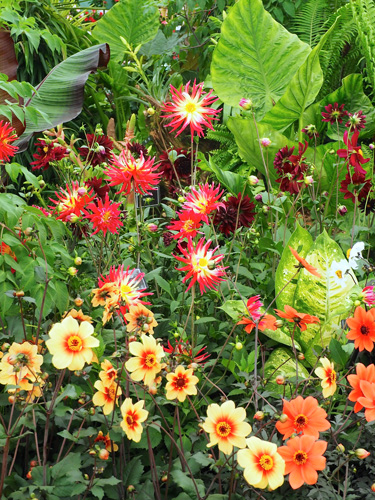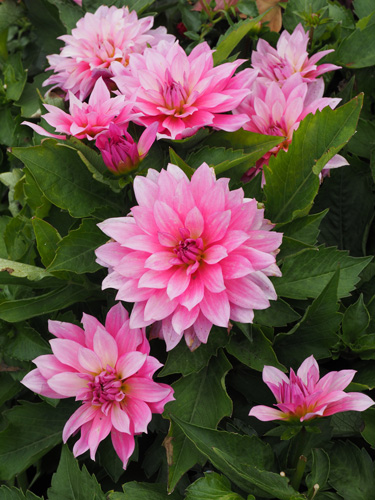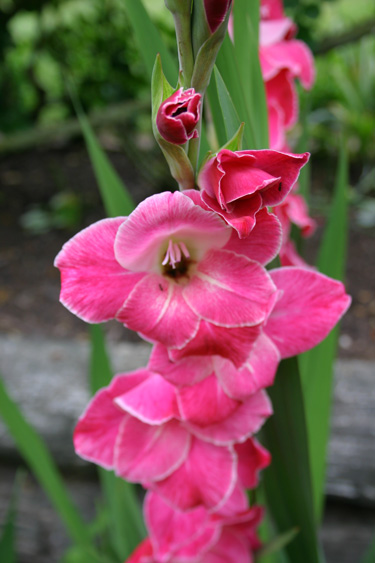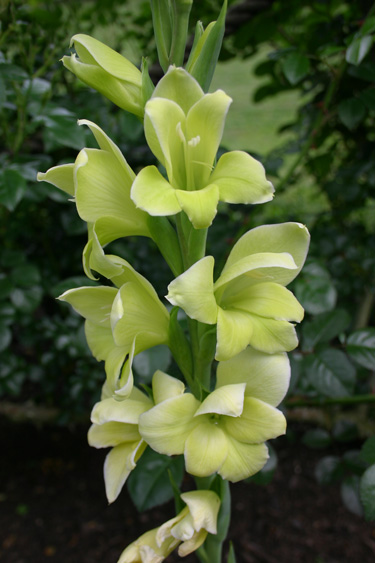Bold and beautiful
Spring is planting time for two classic summer flowers. Both are excellent for picking. Dahlia tubers and gladioli corms arrive in garden centres in August.
Dahlias
Dahlias bloom with extravagant ease from mid summer through autumn. Loved for their sheer generosity of flowers, they’re vase favourites and also make lovely garden plants with attractive green or bronze foliage. Given full sun and a rich free draining soil, they’re not difficult to grow. The main planting time is spring.
Prepare the soil before planting (it’s a good idea to start in autumn), mixing in lots of compost. For each plant mix in about a cup of bone meal or blood and bone. Space tubers 45 to 60cm apart, depending on variety, digging generous holes about 20cm wide and 15cm deep. Settle each tuber snuggly in the soil, adding a bamboo stake to support tall growers. A blanket of mulch limits the need for hand weeding, which can damage surface roots.
In cold climates, time planting to avoid late frosts. Four to six weeks after planting, the shoots will appear above ground. For large growers, place two more stakes about 30cm apart to form a triangle around each plant.
Tip: Once the plants are about 40cm tall, removing the growing tips will stimulate side branching and more flowers.
Picking flowers for indoors and cutting off spent blooms will keep plants blooming throughout summer, but you can have fun creating exhibition quality blooms by getting a bit more scientific. For giant top quality blooms allow only 4-6 shoots per tuber to develop and remove two or three of the pairs of flower buds developing in leaf axils below the main bud.
It’s best to pick dahlias at dawn or dusk. Cut stems on an angle and immediately dip them in 5cm of hot water for a minute. Remove lower surplus leaves, then leave flowers to stand in deep water, ideally for several hours before arranging them in their vase.
Watering, feeding and sensible spacing is the best defense against pests and diseases. If something’s been gnawing on your dahlia buds after dark, earwigs are the likely culprits. Trap them in screwed up newspaper in an overturned pot, then burn the paper.
If your garden is frost-free and not too wet in winter, lifting is only necessary after a few years when the clumps become too crowded to flower well. Otherwise dahlia tubers are best lifted every autumn. Once the tops have died back trim the stems to 15cm above the ground and carefully dig up the cluster of tubers. The entire cluster can be stored for transplanting as is, but to save space you may want to divide them up before storing. To be worth keeping, a tuber must bear a piece of stem tissue with a dormant bud. Leave tubers to dry for a few weeks before packing them in dry untreated sawdust and storing in a dry cool place.
Gladiolus
Loved for picking, gladioli form tall upright flower spikes. They are grown from corms planted in spring to flower approximately 100 days later. A succession of blooms is achieved by planting a fresh batch of corms every week or two from early spring till summer.
Gladioli adapt easily to a variety of climates and can be grown in hot, mild and cold districts. They thrive in well-drained humus rich soil and full sun. The plants may reach 150 cm in height, so it is best if they are sheltered from strong winds. To prevent wind damage, tie three or four plants in a clump to a garden stake just before the flower buds appear.
Flowering takes about 90 to 100 days from planting but it is best to plant so that flowers appear before or after the extreme heat of summer. In warm districts, planting can be made from May to September so that the plants flower before the hottest months. In cold districts it is best to delay planting until August or later. Prepare the soil in advance of planting, adding compost and slow release fertiliser, such as blood and bone. Plant the corms 10 cm deep, spacing them 20 cm apart.
Thrips, insects that thrive in hot dry weather, can seriously deface both foliage and flowers, but you may escape the worst damage with earlier planting. In warm weather, cut flower spikes when the first flowers open. The remaining buds will open indoors if the stems are in water.
Corms can be lifted after the leaves turn yellow and start to die – generally about four to six weeks after flowering. Allow the leaves to dry out, then cut them off close to the corm. Dust the corms with fungicide and store in a dry, cool place until the next planting season.
Summer flowering gladioli come in a wide range of beautiful colours and flower forms. The smaller growing, spring flowering Gladiolus nanus varieties are planted in autumn in a frost-free climate.

12-Aug-2015

Dahlias at Chelsea

Dwarf dahlia

Pink gladiolus


